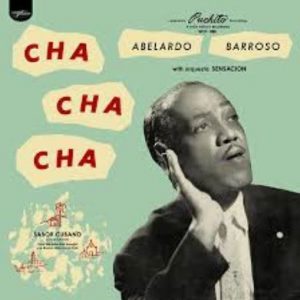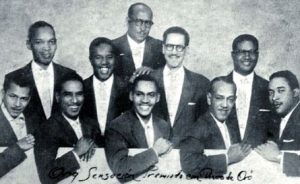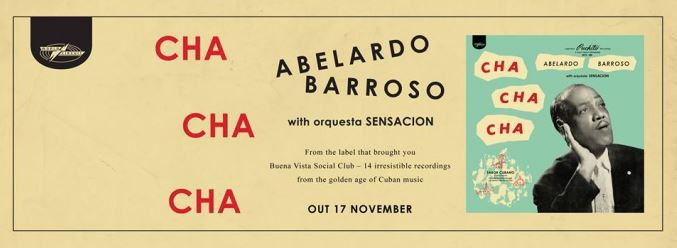Salsa music lovers know Ismael Rivera as “El Sonero Mayor”, but before Ismael was even born, Cuban singer Abelardo Barroso was already touring Europe as the main voice of Cuban “son”, and becoming the first “sonero mayor”.
“Cha Cha Cha” Abelardo Barroso with Orquesta Sensacion
A few months ago I received a copy of “Cha Cha Cha”. I had heard a little about Cuban singer Abelardo Barroso, but really knew little about him. This album opened my eyes and ears to the music of one of the forefathers of our Salsa music.

“Cha Cha Cha” captures Abelardo Barroso perhaps in the best of the 3 main eras he had during his career. These included the era with the Orquesta Sensacion mostly during the 1950s. Barroso and Orquesta Sensacion became a great hit and the 3rd coming of Barroso to the popular music scene. This happened just as Ismael Rivera was starting his singing career in Puerto Rico with the Orquesta Panamericana and later with Rafael Cortijo.
This album captures some of the best hits of Abelardo Barroso. Some of these songs should sound familiar to Salsa music lovers. Classic hits include “Bruca Manigua”, “Yo ‘Ta Cansa”, “Guantanamera”, “Suavecito”, and the famous “El Manisero”.
Barroso’s Career as “Sonero”
Born in La Havana in 1905, Barroso began his music career in 1925 with the Sexteto Habanero in a peculiar way. While working as a taxi driver, he was taking members of the famous Sexteto Habanero to a night club. On the way there, the musicians were signing happily, and Barroso join the singing while driving. The musical director, who was among the passengers, was so impressed, that he hired him on the spot.
Let me state that in the 20’s the Sexteto Habanero was one of the most popular groups of “son” music in Cuba. This was the equivalent of entering El Gran Combo in the late 60’s.
From there, he joined another musical institution when he joined the Septeto Nacional de Ignacio Piñeiro two years later. Piñeiro’s group was also attributed with popularizing the “son”. Their hit “Echale Salsita” was the first known reference to the term “Salsa” used in reference to Afro Cuban music. “Suavecito” was one of Ignacio Piñeiro’s most popular songs. Barroso’s re-recording of it with the Orquesta Sensacion is included in this album. The thing about this version is that you know Barroso was the one who popularized it straight from the legendary author’s pen back in the 20s.

From the 1930s to the 1950s
At the end of the 1920s, Barroso went to tour Spain. He was one of the first Cuban artists to do so. When he returned, he found that the “Danzonete” was the new popular form of music. So the “Caruso del Son” as he was known, adopted the “Danzonete” as well. In this way, he began the second coming of his career in Cuba.
As the recording industry began to take off in Cuba during these years, so did the popularity of Barroso. However, he continued to change groups during the 30’s. In one of those turns, he formed a band with Orestes “Macho” Lopez (father of Orlando “Cachaito” Lopez) and formed the charanga Lopez-Barroso.
During the ’30s the influences of Jazz bands, Charleston, and swing in the U.S., influenced Cuban music, inspiring the creation of the “conjunto”.
As the 1940s came, artists like Arsenio Rodriguez began transforming the conjunto format, adding trumpets, piano, and a conga. Barroso had a hard time adapting to the new formats of the era, and stayed with the old “son” and “danzonete”. By the end of the decade, Abelardo Barroso had been almost forgotten, being remembered as a singer of the “vieja guardia”.
Beny Moré, who had returned from a successful stay in Mexico with the Trio Matamoros, assisted Barroso financially during his hard times. It was then, in the mid-1950s, with the birth and popularity of the “cha-cha-cha”, that Rafael Valdes recruits Abelardo Barroso for his Orquesta Sensacion. Once there, they began adapting new and old songs to his new format. Barroso was a hit, and this marked his third coming in the Cuban music scene.
A Cuban Music Collector’s Gem
The album of “Cha Cha Cha” of Abelardo Barroso is a gem of Cuban music. The songs and his performance on them can clearly show why he was called the “Caruso del Son”. During his career, Barroso showed an incredible ability to improvise. During his years with Orquesta Sensacion, Rafael Valdes decided to bring in a young singer to share singing duties with the veteran Barroso. Their improvisational “controversias” (where each singer improvises verses against his ‘rival’) became a great attraction. This is because the public wanted to see great “soneros” going at it; the old vs. the young.
As one of the first performers of “son”, and one who became popular through this alto voice and his improvisation talent, Abelardo Barroso was truly the first “Sonero Mayor” of Latin music.
In September 1972, while some talented Cuban musicians where forming the band they named Irakere, Abelardo Barroso died in Havana. He left behind a great legacy in Cuban music for others to build from it.

